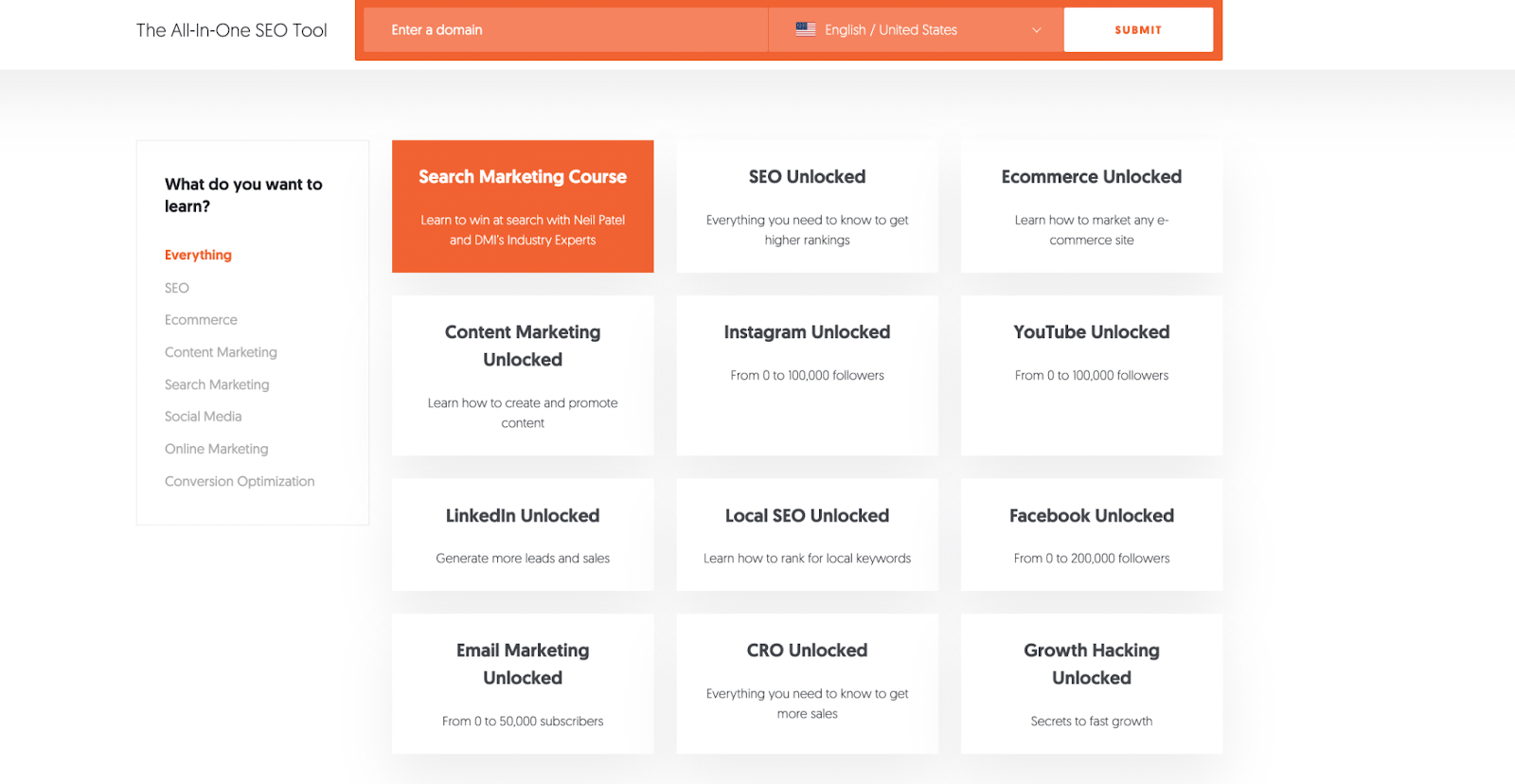There are numerous courses at the moment: Udemy alone has 157,000 courses and 425 million enrollments. There are many more course platforms like Coursera or Masterclass, and influencers offer numerous individual courses online.
Obviously, the competition is fierce. How can you win in the world with so much content, most of it available online?
Well, there are many strategies: you can grow your online presence as an expert, collaborate with other famous experts, or invest a lot in marketing. However, one of the essential steps is choosing the right course name, as it is one of the first things a potential student pays attention to.
In this post, we will explore why catchy names for eLearning are important, how to choose the right one for your own course, and tools that can help you do so. We have also compiled a list of good course title examples to inspire you.
Content:
Why does your course name matter?
At first glance, a course name is the last thing you would care about since it is the knowledge inside it that matters. However, it doesn’t really work that way.
Here are four reasons why you should put effort into your course name:
- It creates the first impression. The course name is the first thing that people will judge you on. Considering that you have only seven seconds to create a first impression and eight seconds of average attention span, it is better to make it count.
- It makes you stand out from the competition. Learners need to differentiate between two courses before they explore their content. It is a quick and easy way to assert your creativity.
- It reflects your brand identity. Well, it should, at least. It may be a strict official name like at the university or have word plays, irony, or other playful topics. Both are good; they just help students identify what kind of brand and tone of voice you offer.
- It helps you set expectations for your students. Just from a couple of words, you send a lot of signals: what kind of an instructor you are, what students can learn, how it will influence their life, etc.
As you can see, the right course name can make or breach the success of your educational program. Thus, let’s discover how to choose a good one!
Tips for choosing the right course name
Choosing a course name in a thoughtful way requires some time and effort. Let’s take a look at what to pay attention to.
Know your target audience
You must have considered who is your target audience before creating your course so go back to your notes. This time, it is important not only to know their demographics but also to dive a little bit deeper.
What is their level of knowledge on this topic? What kind of outcome do they want to see the most? What are their biggest struggles in the topic you present? What do they fear? What might stop them from starting this course? How their age, country, or gender corresponds to their interests, likes, and pain points?
Read our blog on how to find and solve customer pain points, so you can create an education program that fully satisfies your learners’ needs.
You might want to conduct a special survey to learn the answers. Based on the new information, you can choose what kind of language to use, how much terminology you are allowed to utilize, and what kind of outcome or learning barrier to address.
Putting all the puzzle pieces together will give you a more relatable, attractive course name that addresses certain people.
We can call a course “Literary Analysis 101” or “Introduction to Literary Analysis” or you can go for “How to get the most out of books — literary analysis course” or “Why do I like or not like the book — learn to analyze literature.”
Both groups of course title examples convey the information that it is about literary analysis, but they are focused on different target audiences:
- The first group may win at the university because it is in your curriculum, but an online course has higher competition and requires more effort.
- The second group targets people who want to get a richer reading experience or properly review and discuss what they have read.
The infographic down below showcases some tips on how to define your target audience:

Target SEO keywords
SEO matters in the online world, and you should pay attention to it while creating a course name and its description.
Make sure to research what kind of wording people use while researching your topic. You can use Google Keyword Planner, SEMrush, Ahrefs Keyword Explorer, etc.
Read our blog to learn how to pre-sale an online course and make a profit even before the official launch.
You can take the most used keywords as a base and build more details around them. For example, you are making a course about yoga. One of the most searched keywords in yoga is “yoga for beginners,” thus, one of the popular courses on this topic has the name “Yoga for Beginners Course.”

Choose a clear name
We love a good pun in the name — it always sticks to your memory. However, clarity should be above creativity. There are two reasons for that: your audience might not get the clever copywriting, and SEO will get tricky.
If you make a person think too hard or look dumb, they will not likely become your eager students. So before giving your course a creative punny name, test it out on people around you or those who have the level of knowledge that you expect to see in your students.
If they understand it, you have a green light. However, don’t blame them if they did not get your genius idea — just go for an easier option.
Here are great course name examples that go straight to the point.

Highlight an outcome
People don’t really learn for the sake of learning, they don’t care much about the learning method, and they don’t always pay attention to the speaker. It is the result and what they can achieve with the new knowledge that draws them in.
Therefore, make sure to include an outcome and future benefits in your title or at least the first sentence of the description. There may be many benefits, but it is important to choose the one that your audience treasures the most. It can be an easier and faster way of completing something, getting a promotion, increasing the quality of life, getting rid of some problems, etc.
The name of the course down below clearly conveys that a learner can create a profitable online store after completing the educational program.

Explore power words
Power words trigger some emotion or feeling, which are essential in a buying process. Sometimes they may even encourage a person to ignore the price tag.
With power words, you can:
- evoke curiosity: secret, surprising, inspiring, unique, hidden, little-known;
- establish authority: masterclass, blueprint, exclusive, complete, proven, reliable, guaranteed;
- communicate speed: kickstart, in no time, hack, quick tips;
- address the novelty: life-changing, revolutionary, sensational, unexpected.
You can add them to the end of your course name — they usually convey yet another benefit. Some of them seem overused, but they work in most cases.
Discover top online course promotion techniques that can help you attract and retain students.
The name of the education program down below includes the power word “secrets,” which evokes curiosity and promises exclusive information:

Keep it as short as you can
So you should come up with a variety of names, following our advice. Then pick your top five and try to turn them into the shortest versions. You can not really create catchy names for eLearning if you make them too long.
Make sure that your course name is not cut in the search results but still conveys the outcome. Easier said than done but copywriting is always like that: give the most value with the minimum words.
Here’s an example of a brief and catchy course name that conveys the main idea and is easy to memorize:

Course name generators to try
Course name generators can help you brainstorm some ideas and check the availability of a course name. It is a good place to start, but it does need some after-work.
Here are some resources that you might find helpful:
- Business Name Generator. It gives you hundreds of possible combinations, but they will always need edits. You will also need to filter options a lot.
- Thesaurus. If you are looking for a nice and accurate synonym, go for Thesaurus. Just don’t choose the words that nobody knows.
- WeShare. This website will find existing courses on your topic so you can get inspired. However, it is better not to copy any of them to avoid fierce competition.
Consider trying all of these course name generators to get more naming ideas and choose the best one.
Examples of memorable and catchy names for online learning
The theory is good, but it is much easier to learn from course name examples. Let’s take a look.
Complete TikTok Marketing Masterclass: Get Millions of Views
This course title works in many ways: it is obvious that it’s about TikTok marketing, it has powerful words of completeness and authority, and it envisions a dream of every influencer or business, which is to get millions of views. As a result, it is one of the most popular classes in its category.

Backyard Meteorology: The Science of Weather
It is obvious that the course is about meteorology, which is even explained as a science of weather for those who don’t know what it is. However, it is the backyard that is intriguing: it is almost unbelievable that you can predict the weather with no special equipment so you want to explore further.

Learn Indie Filmmaking By Making a Short Film
This is a perfect mix of telling that the course is about indie filmmaking and that the outcome of completing it will be the ability to create a short film of your own. However, it is also about the methods: you will learn indie filmmaking through practice.

Digital Product Management: From Strategy to Launch
The title works since it clearly explains what the course is about, and defines how much you will be able to do after completing it: create a digital product from strategy to launch.

Conclusion
A course name is all about first impressions, expectations, and catching attention. It may be one of the most important things for those who join online course platforms and know nothing about lecturers and their expertise levels.
SendPulse is launching an online course creator, a tool that helps industry experts create engaging and well-structured educational programs. Make sure to monitor the updates in our blog to be among the first ones who will leverage the power of this software, so you can focus on providing high-quality educational materials and monetizing your knowledge, while we will handle all the technical aspects.





![How to Start an Online Course Business [2024 Guide]](https://www.spcdn.org/blog/wp-content/uploads/2024/09/course-business-cover-255x167.png)


